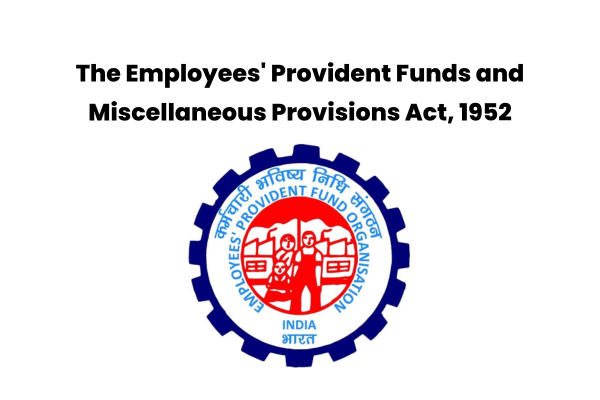Physical Address
Table of Contents
Introduction of Labour Law

Labour laws in India are the backbone of employee rights, shaping how workplaces operate and ensuring everyone gets treated fairly. Knowing these laws isn’t just helpful—it’s essential for anyone in the workforce. These laws cover a wide range of areas like wages, working conditions, social security, and settling disputes. They provide a solid framework for keeping peace in industries and protecting workers’ rights.
India’s labour laws have evolved over time, starting from before independence. They’ve been constantly improved to better protect the dignity and rights of workers. From the Industrial Disputes Act of 1947 to recent updates like the Labour Code on Social Security, these laws reflect years of fine-tuning to meet the changing needs of workers.
In this blog, we’ll take a deep dive into the world of Indian labour laws. We’ll explore ten key facts that every employee should know. By understanding these facts, we hope to give readers the knowledge and confidence to navigate the complexities of modern workplaces. So, let’s embark on this journey together to uncover the essence of labour laws in India and their crucial role in shaping employment.
What are major Labour Law in India: https://www.jagranjosh.com/general-knowledge/list-of-major-labour-laws-in-india-1588921260-1
The Need Of Labour Law

Labour laws are essential to ensure fairness, protect rights, and maintain stability in the workplace. In a rapidly evolving economic landscape, where industries thrive on the labor of millions, these laws serve as the bedrock of employee rights and employer responsibilities. Without labour laws, workers would be vulnerable to exploitation, facing arbitrary working conditions, inadequate wages, and unsafe environments.
Labour laws provide a framework for defining the terms of employment, including wages, working hours, benefits, and safety standards. They establish mechanisms for resolving disputes between employers and employees, ensuring that conflicts are addressed fairly and equitably. Moreover, labour laws promote social justice by addressing issues such as discrimination, harassment, and unequal treatment in the workplace.
Beyond safeguarding individual rights, labour laws contribute to overall economic stability and growth. By promoting fair labour practices, these laws foster a conducive environment for investment, innovation, and productivity. They also play a crucial role in reducing inequality and promoting social cohesion by ensuring that the benefits of economic progress are shared equitably among all members of society.
In essence, labour laws are indispensable for creating a balanced and sustainable relationship between employers and employees. They uphold the principles of justice, equality, and dignity in the workplace, thereby contributing to the overall welfare and prosperity of society.
Here are 10 crucial facts about Indian labour law:
Industrial Disputes Act, 1947
Minimum Wages Act, 1948
Employees’ Provident Funds and Miscellaneous Provisions Act, 1952
Payment of Gratuity Act, 1972
Contract Labour (Regulation and Abolition) Act, 1970
Maternity Benefit Act, 1961
Sexual Harassment of Women at Workplace Act, 2013
Workmen’s Compensation Act, 1923
Factories Act, 1948
Trade Unions Act, 1926
The Industrial Disputes Act, 1947

The Industrial Disputes Act, 1947, is a fundamental piece of Labour Law in India, aimed at maintaining industrial peace and harmony. Enacted shortly after independence, the Act provides a structured framework for resolving conflicts between employers and employees. It seeks to prevent disputes through mechanisms like conciliation, arbitration, and adjudication by Labour Courts and Industrial Tribunals. By addressing issues related to strikes, layoffs, retrenchment, and trade union activities, the Act ensures fair treatment for workers and promotes stable industrial relations. Its provisions are crucial for fostering a conducive environment for economic growth and protecting the rights of workers.
Purpose of the Act:
The purpose of the Industrial Disputes Act, 1947, is to promote industrial peace and harmony by providing a legal framework for the resolution of disputes between employers and employees. It aims to prevent and effectively resolve conflicts arising in the industrial sphere, thereby fostering a conducive environment for sustained economic growth and development. The Act seeks to establish mechanisms for addressing grievances and disputes through conciliation, arbitration, and adjudication, ensuring fairness and equity in employer-employee relations. By regulating industrial disputes and promoting amicable settlements, the Act contributes to the overall stability of the labour market and enhances the welfare of both workers and employers.
Key Provisions of Labour Law: The Industrial Disputes Act, 1947:
- Dispute Resolution Mechanisms: The Act provides for conciliation, arbitration, and adjudication by Labour Courts, Industrial Tribunals, and National Tribunals to resolve industrial disputes.
- Strikes and Lockouts: The Act regulates strikes and lockouts, stipulating notice periods and conditions under which these actions can be deemed illegal.
- Grievance Redressal: Establishes Grievance Redressal Machinery within industrial establishments for the prompt resolution of individual grievances.
- Layoffs and Retrenchment: Sets out conditions and compensations for layoffs and retrenchment, ensuring workers’ rights are protected during these events.
- Trade Union Recognition: Recognizes trade unions and their role in collective bargaining, enhancing workers’ ability to negotiate fair employment terms.
- Government Intervention: Allows for government intervention in disputes deemed of public interest, ensuring timely and effective resolution of significant conflicts.
These provisions collectively aim to maintain industrial harmony and ensure fair treatment for workers, contributing to stable and productive industrial relations.
The Minimum Wages Act, 1948

The Minimum Wages Act, 1948, is a vital piece of Labour Law in India designed to ensure fair compensation for workers. Enacted to protect workers from exploitation, it mandates the establishment of minimum wage rates for various industries and regions. The Act empowers the government to set and periodically revise minimum wages, considering factors like the cost of living and industry standards. By guaranteeing a minimum standard of pay, the Act aims to improve the economic well-being of workers, reduce poverty, and promote equitable growth. It plays a crucial role in safeguarding the financial security and dignity of the workforce.
Importance of Minimum Wages Labour Law
The Minimum Wages Act, 1948, holds immense importance in the Indian labour landscape as it aims to ensure that workers receive fair and adequate compensation for their labour. By setting a legally mandated minimum wage, the Act protects workers, especially those in low-paying and unorganized sectors, from exploitation and ensures they can maintain a basic standard of living.
Minimum wages are crucial for reducing poverty and income inequality. They provide a financial safety net that helps workers meet their essential needs, such as food, housing, education, and healthcare. This, in turn, can lead to improved health and productivity among workers, contributing to overall economic growth and stability.
Furthermore, the Act promotes social justice by ensuring that all workers, regardless of their occupation or industry, receive a fair wage. It helps bridge the gap between the rich and the poor, fostering a more equitable society.
By mandating regular reviews and adjustments of wage rates, the Act ensures that wages keep pace with inflation and changes in the cost of living. This adaptability is crucial for maintaining the purchasing power of workers over time.
How Minimum Wages Labour Law are Determined
Under the Minimum Wages Act, 1948, minimum wages are determined by the government through a process that considers several factors. These factors include the cost of living, the type of work, the industry’s ability to pay, and regional economic conditions. Advisory boards and committees comprising employers, employees, and independent experts are consulted to ensure fair and balanced wage rates. The government periodically reviews and revises these rates to account for inflation and changes in living costs, ensuring that workers’ wages remain adequate and fair over time. This process ensures that minimum wages reflect current economic realities and protect workers’ livelihoods.
The Employees’ Provident Funds and Miscellaneous Provisions Act, 1952

The Employees’ Provident Funds and Miscellaneous Provisions Act, 1952, is a cornerstone of Labour Law in India. It mandates the establishment of provident funds to provide financial security and stability for employees post-retirement. Under this Act, both employers and employees contribute a specified percentage of the employee’s salary to the provident fund. This accumulated fund serves as a crucial savings mechanism, helping employees meet their financial needs during retirement, emergencies, or job transitions. By promoting savings and ensuring financial well-being, the Act plays a vital role in enhancing the economic security of India’s workforce.
Employee benefits
The Employees’ Provident Funds and Miscellaneous Provisions Act, 1952, offers several crucial benefits to employees, providing a robust financial safety net. The primary benefit is the Provident Fund (PF), a compulsory savings scheme where both employees and employers contribute a specified percentage of the employee’s salary each month. Over time, these contributions accumulate, creating a substantial financial reserve for employees.
Upon retirement, employees can withdraw the full amount, ensuring they have a significant sum to support their post-retirement life. This lump sum can be used for various purposes, such as purchasing a home, funding children’s education, or covering medical expenses, thus providing financial stability and independence.
Additionally, the Labour Law includes provisions for the Employees’ Pension Scheme (EPS), which offers a monthly pension to employees who have completed at least 10 years of service. This pension is a lifelong benefit, ensuring a steady income stream during retirement.
Another critical benefit is the Employees’ Deposit Linked Insurance Scheme (EDLI), which provides a lump-sum insurance payout to the nominee in the event of the employee’s death during the service period. This scheme ensures that the employee’s family is financially protected in their absence.
Overall, the Act promotes long-term financial security, encouraging savings and providing vital social security benefits to employees and their families.
Employer Obligations
Under the Employees’ Provident Funds and Miscellaneous Provisions Act, 1952, employers have several key obligations. They must register their establishment with the Employees’ Provident Fund Organization (EPFO) and ensure compliance with the Act’s provisions. Employers are required to contribute a specified percentage of each employee’s salary to the Provident Fund, matching the employee’s contribution. They must also ensure timely deposit of both employee and employer contributions to the EPFO. Additionally, employers are responsible for maintaining accurate records of contributions and facilitating employees’ access to their PF accounts. These obligations ensure employees’ financial security and compliance with the law.
The Payment of Gratuity Act, 1972

The Payment of Gratuity Act, 1972, is a significant legislation in India aimed at providing financial security to employees post-retirement or upon leaving employment. The Act mandates the payment of gratuity, a lump sum amount, to employees who have rendered continuous service for at least five years. It applies to establishments employing ten or more workers and covers a wide range of sectors. The gratuity is calculated based on the employee’s last drawn salary and years of service, ensuring a financial cushion for employees as they transition out of active employment, enhancing their economic stability and security.
eligibility criteria
Under the Labour Law Payment of Gratuity Act, 1972, an employee becomes eligible for gratuity if they have completed at least five years of continuous service with an employer. This eligibility is applicable to employees in factories, mines, oilfields, plantations, ports, railway companies, and shops or establishments with ten or more employees. However, the five-year requirement is waived in case of death or disability due to accident or disease. The Act covers all employees, whether working in a managerial or non-managerial capacity, ensuring that a broad spectrum of the workforce benefits from this financial security measure upon leaving employment.
Calculation of Gratuity
Under the Labour Law Payment of Gratuity Act, 1972, gratuity is calculated based on the employee’s last drawn salary and the number of years of service. The formula is: Gratuity = (Last Drawn Salary × 15 × Number of Years of Service) / 26. Here, the last drawn salary includes basic pay and dearness allowance. The factor 15 represents the days of salary for each year of service, and 26 denotes the number of working days in a month. For employees in seasonal establishments, the gratuity is calculated differently, based on seven days’ wages for each season worked. This calculation ensures fair compensation for long-term service.
The Contract Labour (Regulation and Abolition) Act, 1970

The Contract Labour (Regulation and Abolition) Act, 1970, is a crucial legislation in India aimed at regulating the employment of contract labour and ensuring their welfare. The Act seeks to prevent the exploitation of contract workers by establishing guidelines for their employment, conditions of service, and working conditions. It mandates the registration of establishments employing contract labour and licensing of contractors. Additionally, it provides for the abolition of contract labour in certain situations where it is deemed necessary. By regulating contract labour practices, the Act aims to protect the rights and interests of workers engaged in various industries and sectors.
Regulation of Contract Labour
The Contract Labour (Regulation and Abolition) Act, 1970, regulates contract labour by mandating the registration of establishments employing contract workers and the licensing of contractors. It sets standards for working conditions, including provisions for restrooms, drinking water, and first aid. The Act requires employers to ensure fair wages and timely payment to contract workers. It also mandates that contractors provide health and safety measures. By enforcing these regulations, the Act aims to prevent exploitation, ensure decent working conditions, and protect the rights of contract labourers in various industries.
Rights of Contract Workers
Under the Contract Labour (Regulation and Abolition) Act, 1970, contract workers are entitled to several rights to ensure their welfare and fair treatment. They have the right to fair wages, timely payment, and suitable working conditions. Employers must provide essential facilities such as restrooms, drinking water, and first aid. Contract workers are also entitled to safe and healthy work environments. Additionally, they have the right to raise grievances regarding their employment conditions. These rights aim to protect contract workers from exploitation, ensure their well-being, and promote equitable treatment in the workplace.
The Maternity Benefit Act, 1961

The Maternity Benefit Act, 1961, is a significant legislation in India that safeguards the employment of women during maternity and ensures their right to paid leave. The Act applies to establishments employing ten or more people and mandates maternity benefits for female employees. It provides for a period of paid leave for childbirth, adoption, and miscarriage, along with other related benefits. By offering financial support and job security during and after pregnancy, the Act aims to promote the health and well-being of mothers and their children, ensuring a supportive work environment for women.
Maternity Leave Provisions
The Maternity Benefit Act, 1961, outlines comprehensive provisions for maternity leave, ensuring that women employees receive adequate time off and financial support during and after pregnancy. Under the Act, a woman is entitled to 26 weeks of paid maternity leave for the first two children, and 12 weeks for subsequent children. This leave can be taken up to eight weeks before the expected delivery date, allowing women to rest and prepare for childbirth.
For women adopting a child below the age of three months, or commissioning mothers (those who use surrogates), the Act provides 12 weeks of maternity leave from the date the child is handed over. In addition to this, women who suffer a miscarriage or medical termination of pregnancy are entitled to six weeks of paid leave.
The Act also includes provisions for a one-month leave in case of illness arising out of pregnancy, delivery, premature birth, or miscarriage. During the leave period, women are entitled to receive their average daily wage, calculated based on the wages earned over the three months preceding the leave.
These provisions ensure that women can take the necessary time off work to recover and care for their newborns without financial stress, promoting a healthier and more supportive work environment for female employees.
Benefits for Women Employees
The Maternity Benefit Act, 1961, provides several benefits for women employees. They are entitled to 26 weeks of paid leave for the first two children and 12 weeks for subsequent children, including leave for adoption and surrogacy cases. Women who experience miscarriage or medical termination of pregnancy are granted six weeks of paid leave. Additionally, the Act ensures one month of leave for illness related to pregnancy or childbirth. During these leave periods, women receive their average
The Sexual Harassment of Women at Workplace (Prevention, Prohibition and Redressal) Act, 2013

The Sexual Harassment of Women at Workplace (Prevention, Prohibition and Redressal) Act, 2013, defines sexual harassment as any unwelcome sexually determined behavior, whether directly or by implication. This includes physical contact and advances, demands or requests for sexual favors, sexually colored remarks, showing pornography, or any other unwelcome physical, verbal, or non-verbal conduct of a sexual nature.
The Act recognizes sexual harassment as a violation of the fundamental right to equality and a barrier to women’s participation in work. It emphasizes that sexual harassment creates a hostile work environment and is detrimental to the victim’s dignity and well-being. Importantly, it clarifies
Mechanisms for Redressal
The Sexual Harassment of Women at Workplace (Prevention, Prohibition and Redressal) Act, 2013, outlines several mechanisms for redressal of sexual harassment complaints in the workplace. Firstly, every organization is mandated to establish an Internal Complaints Committee (ICC) consisting of at least one presiding officer and two members, preferably women, trained in handling such cases.
Employees can file complaints of sexual harassment with the ICC within their organization. The ICC is responsible for conducting impartial inquiries into complaints, providing a fair hearing to both the complainant and the respondent, and recommending appropriate action to the employer.
In cases where the complainant is not satisfied with the ICC’s decision or the employer fails to act on the ICC’s recommendations, they can approach the Local Complaints Committee (LCC) established by the district officer or the State Government. The LCC has the authority to inquire into complaints and recommend further action.
Additionally, the Act provides for the option of filing complaints with the police under relevant sections of the Indian Penal Code for criminal proceedings.
These mechanisms ensure that victims of sexual harassment have avenues for redressal and that perpetrators are held accountable for their actions, thereby fostering a safer and more supportive work environment for women.
The Workmen’s Compensation Act, 1923

The Workmen’s Compensation Act, 1923 is a legislation enacted in India to provide financial protection to workers and their dependents in case of injury or death arising out of and in the course of employment. It mandates employers to compensate employees for injuries, disabilities, or death sustained while working, regardless of fault. The Act aims to ensure prompt and fair compensation to workers and their families, thereby promoting social security and welfare in the workforce. It establishes a framework for adjudicating claims and specifies the liability of employers to provide financial assistance to employees affected by workplace accidents or occupational diseases.
Employer Liability
The Workmen’s Compensation Act, 1923 imposes a strict liability on employers to compensate their employees for work-related injuries, disabilities, or death, regardless of fault or negligence. Employers are obligated to provide financial assistance to workers or their dependents in case of any injury, disablement, or death arising out of and in the course of employment. This liability extends to accidents that occur on the premises of the workplace, during work-related travel, or while engaged in activities directly linked to their employment.
The Act specifies that employers must compensate employees for medical expenses incurred due to the injury, loss of wages during the period of incapacity, and lump-sum payments for permanent disabilities or death benefits to the dependents of deceased workers. Employers are required to adhere to the provisions of the Act and provide timely compensation without any delay or discrimination.
Failure to comply with the provisions of the Act may result in legal consequences, including fines and penalties imposed on the employer. The Act aims to ensure the welfare and protection of workers by holding employers accountable for maintaining a safe working environment and providing financial support in case of work-related injuries or fatalities. It establishes a legal framework to safeguard the rights and interests of employees and promote workplace safety and security.
Compensation for Workers
The Workmen’s Compensation Act, 1923 mandates that workers who suffer injuries, disabilities, or death during the course of employment are entitled to compensation from their employers. This compensation includes reimbursement for medical expenses incurred due to the injury, payment for loss of wages during the period of incapacity, and lump-sum settlements for permanent disabilities or death benefits for dependents of deceased workers. The Act ensures that workers receive prompt and fair compensation for work-related injuries or fatalities, providing financial support to alleviate their financial burden and promote their welfare and well-being.
The Factories Act, 1948

The Factories Act, 1948 is a legislation enacted in India to regulate the working conditions in factories and ensure the health, safety, and welfare of workers. It applies to premises where manufacturing processes are carried out with the aid of power and employing ten or more workers, or without power and employing twenty or more workers. The Act sets standards for workplace safety, hygiene, and welfare amenities such as ventilation, lighting, cleanliness, and drinking water. It also outlines provisions for regulating working hours, overtime, holidays, and employment of young workers, aiming to create a conducive and healthy working environment in factories.
Health and Safety Regulations
The Factories Act, 1948 establishes health and safety regulations to ensure a safe working environment in factories. It mandates measures to prevent accidents and occupational hazards by enforcing standards for workplace conditions, machinery safety, and handling of hazardous substances. The Act requires employers to provide adequate ventilation, lighting, and cleanliness, as well as facilities for maintaining proper sanitation and hygiene. It also mandates the appointment of safety officers, implementation of emergency procedures, and provision of protective equipment to workers. These regulations aim to protect the health and well-being of factory workers and minimize the risk of injuries and illnesses in the workplace.
Working Hours and Conditions
The Factories Act, 1948 regulates working hours and conditions in factories to ensure the well-being of workers. It limits the number of hours adults can work per day and mandates rest intervals and weekly holidays. The Act prohibits employment of young workers during certain hours and specifies their maximum working hours. It also sets guidelines for overtime work, ensuring adequate compensation and rest periods. Additionally, the Act addresses issues such as employment of women during night shifts and provides for their safety and welfare. These provisions aim to promote a balanced work-life environment and safeguard the rights and health of factory workers.
The Trade Unions Act, 1926

The Trade Unions Act, 1926 is a legislation enacted in India to provide legal recognition and protection to trade unions. It defines a trade union as any combination of workers or employers formed to regulate employment relations and promote their economic and social interests. The Act outlines the registration process for trade unions, granting them legal status and immunity from certain civil and criminal liabilities. It safeguards the rights of workers to form and join trade unions, engage in collective bargaining, and participate in industrial disputes. The Act serves as a foundation for organized labor movements and fosters a fair and balanced industrial relations framework.
Formation of Trade Unions
The Trade Unions Act, 1926 permits the formation of trade unions by workers or employers to collectively protect their interests. Any seven or more members can form a trade union, provided they are engaged in similar trades, occupations, or industries. The union must adopt rules, appoint office bearers, and register with the appropriate government authority. Registration grants legal recognition, enabling unions to function effectively, negotiate with employers, and represent members in disputes. The Act facilitates the organization of workers and employers into cohesive units, empowering them to address common concerns and advocate for improved working conditions and fair treatment in the workplace.
Rights and Privileges of Trade Unions
The Trade Unions Act, 1926 grants several rights and privileges to registered trade unions. These include the right to conduct legal proceedings in their own name, acquire and hold property, and enter into contracts. Trade unions can also represent their members in industrial disputes, negotiate collective agreements with employers, and participate in tripartite forums. Additionally, they have the privilege of immunity from certain civil and criminal liabilities, enabling them to function effectively in advocating for the rights and interests of their members. These rights and privileges empower trade unions to play a vital role in promoting workers’ welfare and protecting their rights in the workplace.
Recent Amendments and Future Prospects
Labour Code on Wages, 2019

Recent amendments to the Labour Code on Wages, 2019 have aimed to streamline wage-related regulations and enhance transparency in payment systems. These amendments seek to simplify wage calculation methods, ensure timely payment of wages, and establish uniformity in wage structures across industries and regions. The future prospects of the Labour Code on Wages include fostering greater compliance with wage laws, promoting fair wages for workers, and facilitating economic growth by improving labor market efficiency. The code’s emphasis on ensuring just and equitable remuneration for all workers aligns with broader goals of social justice and inclusive economic development.
Recent Amendments and Future Prospects
Labour Code on Social Security, 2020

Recent amendments to the Labour Code on Social Security, 2020 have aimed to modernize and expand social security coverage for workers in India. These amendments introduce comprehensive provisions for social security benefits, including health insurance, maternity benefits, pension schemes, and disability coverage. The future prospects of the Labour Code on Social Security include enhancing the welfare of workers, promoting inclusivity, and mitigating socio-economic vulnerabilities. By strengthening social security mechanisms, the code seeks to provide a safety net for workers and their families, fostering resilience and socio-economic stability in the face of various life challenges.
Conclusion
Summary of Key Points
Understanding labour laws is crucial for employees to safeguard their rights and ensure fair treatment in the workplace. Staying informed about these laws helps in navigating employment terms effectively.
Importance of Staying Informed
Employees must stay updated on labour laws to protect their interests and seek legal recourse when necessary. Awareness and knowledge empower employees to ensure a fair and safe working environment.

